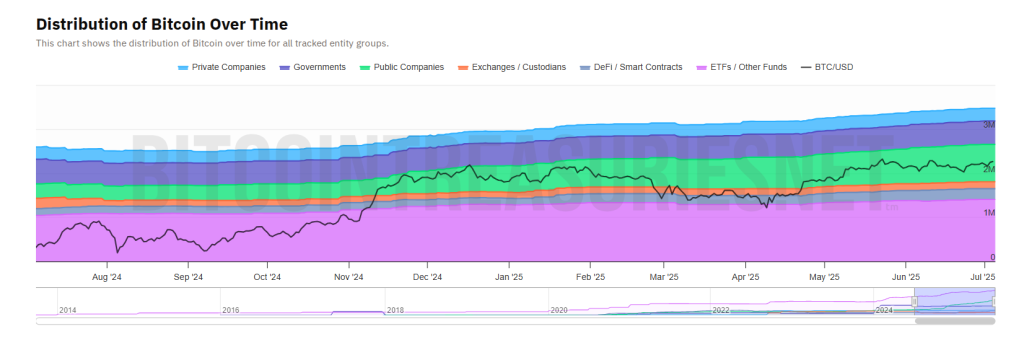Bitcoin Giants Shrink: Whales Quietly Hand Off Billions To Institutions

Bitcoin Giants Shrink: Whales Quietly Hand Off Billions to Institutions
Summary: Bitcoin’s price remains stable around $108,100 as major holders — long-time whales — offload over 500,000 BTC. The massive transfer reflects a significant ownership shift, with institutions emerging as dominant players in the market.
Whales Pass the Torch
In a major shift within the Bitcoin ecosystem, whales — early adopters and large-scale miners — have sold more than 500,000 BTC over the past 12 months, equivalent to over $50 billion at current prices. This transition is being driven by a gradual rebalancing of supply from massive individual holders to institutions and fund-managed wallets.
According to Bloomberg’s review of 10x Research data, wallets containing between 1,000 and 10,000 BTC saw their holdings shrink from over 4.5 million BTC in January 2023 to approximately 4.47 million BTC by July 2025. Conversely, addresses holding between 100 and 1,000 BTC surged from roughly 4 million to 4.77 million over the same period — a sign that mid-tier investors, including hedge funds and family offices, are absorbing the supply.
This reallocation is occurring via in-kind transfers and private deals, largely bypassing public exchanges and enabling discreet positioning by institutional players.

Institutions Ramp Up Their Stakes
Institutional investors have rapidly increased their Bitcoin exposure, effectively replacing whales as the dominant holders. Data from Bitcoin Treasuries reveals private companies boosted holdings from 279,374 BTC in July 2024 to 290,883 BTC currently. Meanwhile, public corporations expanded their reserves from 325,400 BTC to a substantial 848,600 BTC.
Exchange-traded funds (ETFs) have led institutional accumulation, growing from 1,039,000 BTC to 1,405,480 BTC over the past year. Altogether, institutions acquired approximately 899,198 BTC — valued at more than $96 billion. This steady inflow has helped stabilize market conditions even as traditional whales reduce their positions.
Market Behavior and On-Chain Shifts
The influx of institutional demand has influenced the overall distribution of Bitcoin across wallet sizes. While the largest holders reduce their stacks, a growing number of mid-sized wallets indicates broader structural changes driven by regulated investor participation.
Edward Chin, co-founder of Parataxis Capital, explained that the trend of in-kind transfers enables large BTC positions to move from anonymous entities into regulated institutions, facilitating oversight and reducing market disruption caused by large exchange-based trades.
Price Stability and Volatility Decline
As Bitcoin gets absorbed by long-term, institutional capital, market volatility has declined notably. Deribit’s 30-day volatility index has dropped to its lowest point in two years, signaling a maturation in Bitcoin’s investor base.
Jeff Dorman, Chief Investment Officer at Arca, likened today’s Bitcoin investment profile to a dividend-paying asset that could yield 10–20% annually — a stark contrast to the 1,400% surge experienced in 2017. While less explosive, this consistency is becoming increasingly appealing to long-term investors.
However, concerns remain. Fred Thiel, CEO of MARA Holdings, noted his firm continues to hold all mined BTC but cautioned that if whales accelerate their selling and institutional demand softens, Bitcoin prices could face renewed downward pressure.
Featured image from Meta, charts courtesy of TradingView











